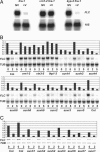LHP1, the Arabidopsis homologue of HETEROCHROMATIN PROTEIN1, is required for epigenetic silencing of FLC
- PMID: 16549797
- PMCID: PMC1458786
- DOI: 10.1073/pnas.0507427103
LHP1, the Arabidopsis homologue of HETEROCHROMATIN PROTEIN1, is required for epigenetic silencing of FLC
Abstract
Vernalization is the acceleration of flowering by prolonged cold that aligns the onset of reproductive development with spring conditions. A key step of vernalization in Arabidopsis is the epigenetic silencing of FLOWERING LOCUS C (FLC), which encodes a repressor of flowering. The vernalization-induced epigenetic silencing of FLC is associated with histone deacetylation and H3K27me2 and H3K9me2 methylation mediated by VRN/VIN proteins. We have analyzed whether different histone methyltransferases and the chromodomain protein LIKE HETEROCHROMATIN PROTEIN (LHP)1 might play a role in vernalization. No single loss-of-function mutation in the histone methyltransferases studied disrupted the vernalization response; however, lhp1 mutants revealed a role for LHP1 in maintaining epigenetic silencing of FLC. Like LHP1, VRN1 functions in both flowering-time control and vernalization. We explored the localization of VRN1 and found it to be associated generally with Arabidopsis chromosomes but not the heterochromatic chromocenters. This association did not depend on vernalization or VRN2 function and was maintained during mitosis but was lost in meiotic chromosomes, suggesting that VRN1 may contribute to chromatin silencing that is not meiotically stable.
Conflict of interest statement
Conflict of interest statement: No conflicts declared.
Figures




References
Publication types
MeSH terms
Substances
LinkOut - more resources
Full Text Sources
Molecular Biology Databases

